
Truck production at the Wörth plant
Special report
A cab and a chassis come together every three minutes at the Mercedes-Benz plant in Wörth. Produced down to the finest details according to the "Trucks you can trust" ethos.This plant has been writing truck history for 50 years now.
400 vehicles a day, well over three million in total: the Mercedes-Benz factory in Wörth is the world's largest truck assembly plant. Trucks have been in production here for 50 years. Much has changed over this time. But there has been one enduring constant: every vehicle which leaves the plant has earned its Mercedes star.
The production process begins with the body-in-white. After the sheet metal panels have been welded together, the first visual check is carried out: four cameras mounted on robots' arms scan the relevant items. "Every cab has to undergo this quality inspection," says Jürgen Olberding, head of the body-in-white department. In this way, possible problems are identified at an early juncture and duly eradicated. The inspection system raises the alarm on detecting minimal deviations of 1.5 millimetres. Such deviations are virtually never attained in the production process, however. And when they do occur, the cab undergoes another in-depth examination in a separate adjoining room. Should the deviations be confirmed, this is the time to take countermeasures in the production department. "Drivers can be assured that the cabs in which they sit possess absolute Mercedes quality," says Olberding.
After the body-in-white stage, the cab moves on to the paint shop. The first primer coat is applied to all the surfaces in the cataphoretic immersion primer bath. Subsequent sealing of the seams and sheet metal flanges offers additional protection from corrosion. The cab is then provided with a filler coat which protects the sheet metal from damage to the paintwork as a result of flying stones, for example. Only then is the actual paint finish applied. "Since 2003 we have invested over 100 million euros in a complete modernisation of the paintshop, in environment-friendly processes and in fully automated systems. This guarantees maximum quality and reliability," says paintshop manager Ulrich Zimmer. "The onus is still on the individual employee, however. Ultimately, high quality can only be assured by a well trained eye."

High-powered precision: Robots are indispensable in body-in-white production – when it comes to performing thousands of spot welds and fitting the sheet metal panelling, for example.
Next stop: Interior fit-out. Here, the great challenge is the enormous diversity involved. Euro VI or Euro V, left- or right-hand drive, Actros, Antos, Arocs, Axor or Atego – production at Wörth covers the whole motley array of different model series and model variants, from new and established lines alike.The new Actros results in a further substantial rise in complexity. In comparison to its predecessor, the new model entails a two-fold increase in the number of parts to be installed, for example. What's more:"We apply extremely high quality standards, to ensure that the driver feels perfectly at home," notes Dr. Jörg Krummel, head of the interior equipment and appointments.In addition to in-process quality control, eight cabs undergo in-depth inspection every day.
Finally, the cab is ready for the "wedding" - the joining of the cab and chassis. Due to the enormous loads to which the vehicles are exposed in daily operations, the longitudinal and cross members are connected with bolts and rivets. The chassis is then painted, before the engine and transmission are installed. For the sake of clarity, the holes of the longitudinal frame member are marked with a laser. "For each individual hole pattern in the four-row hole arrangement, the laser markings indicate the part which is to be fitted and the tightening torque for the bolted connection," says Peter Arnecke, head of the body assembly department. The next stop is the roller dynamometer. Here, each truck is required to demonstrate that all its systems work perfectly. The results are documented and archived for up to 25 years.

Like clockwork: Just-in-time delivery to the fit-out assembly line.
The production process ends with a visual inspection of the vehicle in the light tunnel. Only then do the staff release the truck – in the sure knowledge that the vehicle concerned has earned its star once again. Just like all the vehicles that went before it throughout the plant's 50-year history."We are guided in all areas by our brand claim, 'Trucks you can trust'", says Helmut Bachmann, head of vehicle production at the Wörth plant."This provides our customers with the assurance that they can rely on trucks bearing the Mercedes star. It is the understanding that we have to earn this trust in our products anew every day that motivates us in our daily work."



Comment
Please log in to post a comment.
1 comment